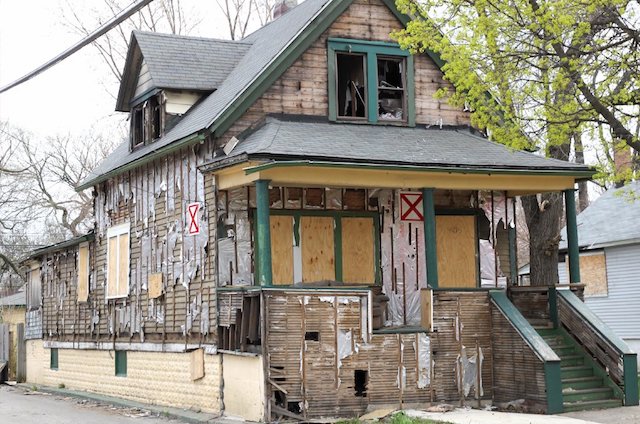One of the clichéd details people use to describe a seemingly rundown neighborhood is the assemblage of plywood boards that seal off entryways in vacant properties. That could soon change—at least, in Chicago.
In late June, 11th Ward alderman Patrick Daley Thompson (latest scion of the Daley family) introduced an ordinance in City Council that would ban owners of vacant buildings from boarding up their property with plywood or any other wood-based material. (Eight other aldermen signed onto the legislation, which has been referred to committee.) “The plywood doesn’t wear well,” Thompson says. “It’s not as secure, and I think it just has a negative connotation in neighborhoods where you see houses boarded up and boards are broken.”
A complete plywood ban has been several years in the making. Under Mayor Richard M. Daley, the city prohibited plywood from being used to board up holes bigger than one square foot for more than half a year. And in early 2016, City Council explicitly allowed for the use of polycarbonate and plexiglass—transparent material that often makes a vacant property look occupied. (Rented steel board-ups are also allowed, but their cost tends to add up over time.) Still, owners of vacant buildings have continued to prefer plywood—which is, at least initially, cheaper than other options—hence the ban.
“The cost [of boarding up] is typically borne by the banks, and they don’t do as good of a job of maintaining the properties as they should,” says Thompson. “Either steel or clear product are much better, and this will hopefully hold lenders and big banks accountable.” Thompson also adds that, over time, polycarbonate boarding tends to be cheaper, since it requires less frequent replacement.
In fact, the country’s most popular polycarbonate board-up system was a Chicago invention. In 2013, Howard Wedren, founder of real estate developer Dayton Street LLC, patented an “internal anchor board-up system.” The company he started, SecureView, was later bought by Robert Klein of Safeguard Properties, a foreclosure inspection company. (In 2015, Safeguard settled with the Illinois Attorney General for $1 million over accusations that it was illegally breaking into homes, locking residents out, and removing their personal belongings.)
SecureView is used in more than 10,000 municipalities across the country, according to Aaron Marcovy, its director of communications. Its rise comes in tandem with the demise of plywood: in 2017, Ohio became the first state to ban plywood from being used as board-up material, the same year Fannie Mae required all its properties to be sealed with clear material or repaired. (Both Klein and Wedren, by the way, are not infrequent political donors. Dayton Street, Wedren’s firm, has twice given money to Thompson: in June 2016—right before Dayton Street finished leasing on a big industrial site in the 11th Ward—and then again this past December. They also sent Rahm’s reelection campaign a cool $5,000 earlier this month.)
Apart from cost, the argument for making the shift hinges on two other factors: safety to first responders, and the optics of a better-looking neighborhood. “When first-responders go to a property that’s boarded with plywood, they have no clue, no idea what’s inside that property,” Klein told City Council in 2016. “With this polycarbonate clear boarding, the first responders see inside the property before they go in there. It really is a life-saver.” An Ohio fire department chief, however, told NPR last year that one has to cut through polycarbonate with an electric saw, instead of using a traditional pickaxe—which takes only seconds. (A spokesperson for the Chicago Fire Department said CFD is still studying the proposed changes.)
But the more prominent and publicized argument is, as Thompson’s proposed ordinance puts it, that “the aesthetics that plywood boarded up buildings convey casts a negative perception over the community.” This argument for beautification is rooted in economics; a paper sponsored by Community Blight Solutions, another of Klein’s companies, found that home values increased in neighborhoods that used clear boarding instead of plywood.
As Brentin Mock wrote last year in a CityLab essay on the use of the word “blight,” the framework of blight has frequently been a way for planners and policymakers to paint certain communities as pathological, thereby justifying their criminalization. In the realm of the plywood-to-polycarbonate shift, it’s hardly difficult to identify who’s responsible for exacerbating urban decay, and thus depressing economic value. As Fran Spielman wrote in the Sun-Times: “Chicago's epidemic of abandoned buildings have long been a magnet for vagrants, prostitutes, gang-bangers, and drug dealers.”
From Marcovy’s perspective, clear boarding allows police to see if there’s illegal activity occurring in a property before they enter. It also “allows a neighborhood to self-police and be able to report issues if they see people inside of building where they shouldn’t be, as opposed to the comfort that a squatter might find behind a boarded-up property.
“There’s an immediate effect there,” he says. “It doesn’t send a visual signal to the community that this is a neglected neighborhood where crime is welcome.”



